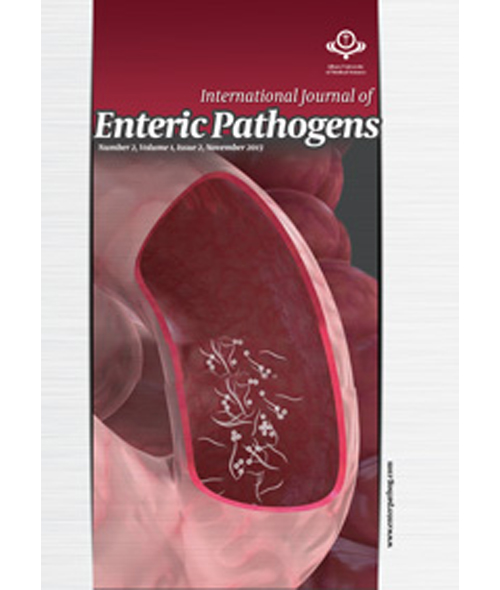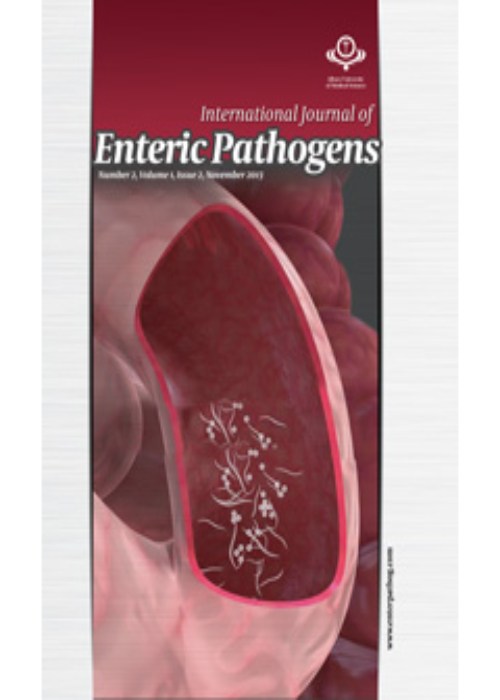فهرست مطالب

International Journal of Enteric Pathogens
Volume:7 Issue: 2, May 2019
- تاریخ انتشار: 1398/03/04
- تعداد عناوین: 7
-
-
Page 30
-
Pages 31-36BackgroundApparently healthy individuals could serve as reservoirs and disseminators of extended-spectrum cephalosporin (ESC)- and cephamycin (cefoxitin, FOX)-resistant, and extended-spectrum β-lactamase-producing (ESBL-P) Escherichia coli which jeopardizes antibacterial therapy thereby posing a threat to the health of infected individuals/carriers.ObjectivesThis study aimed to screen healthy asymptomatic students in the University of Nigeria, Nsukka (UNN) as potential reservoirs of ESC- and FOX-resistant and ESBL-P E. coli and to determine the antibacterial resistance profile.Materials and MethodsAnal swabs were collected from 190 randomly selected healthy asymptomatic students of both genders in UNN between March and July 2018. ESC-resistant E. coli was isolated using MacConkey agar with 2 μg/mL ceftazidime. ESBL production was assessed by combination disc method while cephamycin resistance was determined using cefoxitin disc screening. Phenotypic resistance of the isolates was determined using disc diffusion method.ResultsOut of 190 samples, 20 (10.2%) demonstrated growth. Of these, 6 (30%) were FOX resistant (putative AmpC-producers) but none produced ESBL. The resistance of the isolates was 100% to ampicillin (AMP), 95% to ceftazidime (CAZ), tetracycline (TET) and sulfamethoxazole-trimethoprim (SXT), 30% to FOX and chloramphenicol (CHL), 85% to ciprofloxacin (CIP), enrofloxacin (ENR) and streptomycin (STR), and 65% to kanamycin (KAN). All the isolates were susceptible to meropenem (MEM). Among the 20 isolates, 1 (5%) was resistant to 2 classes of antibacterial agents while 19 (95%), including all the FOX-resistant strains, were resistant to ≥ 3 classes of antibacterial agents. The isolates exhibited 11 multiple antibacterial resistance patterns with AMP, CAZ, FOX, TET, CIP, ENR, STR, KAN, SXT being predominant.ConclusionHealthy asymptomatic students in UNN are potential reservoirs and disseminators of ESC- and cephamycin (FOX)-resistant E. coli.Keywords: Escherichia coli, Healthy University students, Cefoxitin resistance, Extended-spectrum cephalosporin resistance, Extended-spectrum ?-lactamase production
-
Pages 37-43BackgroundBiofilm is a surface adhered extracellular polymer matrix produced by bacteria. The establishment of biofilms is considered as an important pathogenic trait in many chronic infections and antibiotic resistance.ObjectiveThe present study was intended to evaluate biofilm forming potency and antibiotic resistance (AR) pattern in clinical and non-clinical bacterial isolates, and their phylogenetic characterization.Materials and MethodsA total of 82 bacterial isolates were obtained from clinical settings and animal farms from southern (Kushtia-Jhenaidah) region of Bangladesh. Biofilm forming potentials and AR profile were evaluated by standard biofilm assay and Kirby-Bauer disk diffusion method, respectively. Further, antibiotic exposure was assessed by multiple antibiotic resistance (MAR) value indexing. Furthermore, statistical methods were applied to estimate the relationship between AR and biofilm formation. Finally, selected isolates were characterized by morphological and biochemical tests, as well as 16S rRNA gene sequencing.ResultsClinical isolates showed higher biofilm formation (OD595=1.17±0.03) than non-clinical isolates (OD595=0.68±0.03). Among all, Pseudomonas isolates produced the highest amount of biofilms (OD595=2.08±0.02). The AR profiles fell within 46.67-86.67% and MAR index ranged from 0.47 to 0.87. Moreover, a significant positive correlation (P<0.05) was found between biofilm formation and AR. Eventually, heavy biofilm producers with ≥60% resistance profile were characterized and identified as Escherichia coli, Cronobacter sakazakii, Pseudomonas aeruginosa, Staphylococcus sciuri, and Staphylococcus aureus.ConclusionIn general, biofilm formation and MAR were highly correlated regardless of the source, type, and environment of the isolates. Therefore, a rigorous evaluation of both biofilm formation and AR is demanded to minimize AR and associated problems.Keywords: Antibiotic Resistance, Biofilm Formation, Pseudomonas aeruginosa, Staphylococcus aureus, Escherichia coli, Cronobacter sakazakii
-
Pages 44-48BackgroundCurrency notes are used as a means of exchange during buying and selling of goods and commodities; thereby making them agents of disease transmission.ObjectiveThe aim of this study was to evaluate the rate of contamination posed on these currency notes in Akure metropolis by parasites.Materials and MethodsA total of 160 different naira notes (5, 10, 20, 50, 100, 200, 500 and 1000) were collected from food vendors, butchers, petrol attendants and fishmongers into transparent containers and transported to the laboratory. Based on the physical appearances of the notes, they were categorized as mint, clean, dirty, very dirty and mutilated. Standard parasitological techniques were employed to detect parasitic organisms on the notes.ResultsOf the 160 naira notes examined, 106 (66.3%) harbored eggs and other stages of the parasites. Mint notes did not harbor any parasite. 14 (70%) of clean notes, 31 (62%) of dirty notes, 61 (74.4) of very dirty and mutilated notes were contaminated, respectively. Parasites recovered from naira notes included Enterobius vermicularis (19.8%), Hookworm (8.5%), Giardia lamblia (22.6%), Ascaris lumbricoides (77.4%), Hymenolepis nana (21.7%), Strongyloides stercoralis (10.4%), Trichuris trichiura (25.5%), Isospora belli (2.8%), Entamoeba histolytica (87.7%), Balantidium coli (34%) and flagellates (7.5%). We found that 5, 50 and 100 naira notes had the highest contamination (45%) while 20 and 1000 naira notes had the least contamination (35% each). The results showed that there was a significant difference between the sources of the collection (P<0.05).ConclusionCitizens should be educated on ways of handling money through personal hygiene by not abusing, mishandling or mutilating the currency notes.Keywords: L Parasite, Contamination, Currency Note, Denomination, Mutilated, Mint
-
Pages 49-54BackgroundBloodstream infections are considered a significant medical concern associated with high morbidity and mortality rates. Therefore, physicians should be guided to use antimicrobial susceptibility patterns in order to select appropriate empiric antimicrobial agents to treat the patients who suffer from bacteremia.ObjectiveThe present study aimed to determine antimicrobial resistance and susceptibility patterns in isolates collected from bloodstream infections.Materials and MethodsTo achieve this, a total of 710 bacterial blood culture isolates were collected from Sina hospital, and then susceptibility patterns to a number of antibiotics were analyzed according to Clinical and Laboratory Standards Institute guidelines.ResultsThe identified isolates included Staphylococcus aureus 14 (20.6%), Escherichia coli 14 (20.6%), Acinetobacter baumannii 12 (17.6%), Pseudomonas aeruginosa 11 (16.2%), Coagulasenegative Staphylococcus 8 (11.8%), Klebsiella pneumoniae 6 (8.8%), and Enterobacter spp. 3 (4.4%). The total resistance rate to co-trimoxazole, ceftriaxone, ceftazidime, cefotaxime, ofloxacin, gentamicin, ciprofloxacin, levofloxacin, amikacin, and imipenem was 44 (64.7%), 42 (61.8%), 39 (57.4%), 38 (55.9%), 35 (51.51%), 32 (47.1%), 31 (45.6%), 25 (36.8%), and 27 (39.7%), respectively. Finally, the susceptibility rate to amikacin and imipenem was 43 (63.2%) and 41 (60.3%), respectively.ConclusionIn general, A. baumannii strains isolated from blood cultures were resistant to most antibiotics and the greatest sensitivity was observed to gentamicin (58.3%) compared to other antibiotics. Therefore, gentamicin was found as the most effective antibiotic for treating bloodstream infections caused by A. baumannii.Keywords: Bloodstream infection, Antimicrobial susceptibility pattern, Bacterial species
-
Pages 55-59BackgroundNon-typhoidal salmonellae and serovars of Escherichia coli, Listeria, Shigella, and Campylobacter are among the most important food-borne bacterial agents.ObjectiveThe aim of the present study was molecular detection of quinolone resistance in Salmonella spp. isolated from poultry products in Karaj, Iran, using polymerase chain reaction (PCR).Materials and MethodsNinety samples of poultry products were collected from different brands and markets during September-December 2017. All samples were enriched in nutrient broth and Selenite F broth, and salmonellae were isolated by xylose lysine deoxycholate agar. The presence of specific genes of qnrA, qnrB, and qnrS was investigated employing PCR technique and subsequently, specific primers.ResultsNone of the 30 egg yolk samples had bacterial growth in the culture medium. In total, 29 (48.33%) out of 60 raw chicken meat samples were determined to be contaminated with Salmonella using culture-based methods (i.e., 7 (35%) out of 20 drumstick, 15 (62.5%) out of 24 breast, and 7 (43.75%) out of 16 liver samples). In addition, the frequency of qnrA, qnrB, and qnrS genes in the samples was 10.34%, 68.96%, and 86.20%, respectively.ConclusionThe results of this study showed a high frequency of Salmonella contamination and qnr genes in the contaminated samples.Keywords: Salmonella, Poultry Product, Quinolone Resistance, qnr genes
-
Pages 60-67BackgroundFood spoilage and foodborne diseases are two important problems in the food industry. On the other hand, consumers’ tendency to use natural additives is increasing. Hence, plant essential oils (EOs) can be safe alternatives in this regard.ObjectiveThe objectives were to determine the chemical composition and to evaluate the antimicrobial activity of Cymbopogon citratus EO against some foodborne bacteria alone and in combination with Origanum majorana and Caryophyllus aromaticus EOs. Materials andMethodsChemical composition of C. citratus EO was analyzed by gas chromatography-mass spectrometry. Further, antibacterial activity of the EO against foodborne bacteria was assessed using disk diffusion method. In addition, the minimum inhibitory concentration of the EO was determined by microdilution broth method and then the minimum bactericidal concentration value was determined. Checkerboard synergy testing was also performed to determine the fractional inhibitory concentration index. Finally, time-kill curves were drawn based on the bacterial population (CFU/mL) against time (h).ResultsThe major compounds of C. citratus EO were isothymol, thymol, trans-caryophyllene, and cymene. The most and the least sensitive foodborne bacteria to C. citratus EO were Staphylococcus aureus and Bacillus subtilis, respectively. The minimum inhibitory concentration (MIC) values of C. citratus EO against all the evaluated bacteria were 0.1% and The minimum bactericidal concentration (MBC) values ranged between 0.1 and >2% (v/v). The combination of C. citratus and O. majorana EOs showed a synergistic activity against Salmonella typhimurium and partial synergism against B. subtilis, Escherichia coli O157:H7, S. aureus, and Listeria monocytogenes. Moreover, the combination of C. citratus and C. aromaticus EOs demonstrated partial synergism against S. aureus and L. monocytogenes, and additive interaction against S. typhimurium; however, the combination was indifferent against E. coli O157:H7 and B. subtilis. Furthermore, C. citratus plus O. majorana EOs and C. citratus plus C. aromaticus EOs showed a bactericidal effect against S. typhimurium after 24 hours in the time-kill assay.ConclusionIn general, the synergism, partial synergism, and additive effects of C. citratus in combination with C. aromaticus and O. majorana EOs strengthen the antimicrobial activity, expand the spectrum of activity, reduce the concentrations required, decrease the side effects, and prevent the alteration of organoleptic properties of food.Keywords: Antimicrobial activity, Origanum majorana, Cymbopogon citratus, Caryophyllus aromaticus, Essential Oils, Chemical composition


